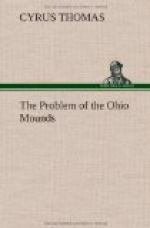Pickett says [Footnote: Hist. Alabama, 3d ed., vol. 1, p. 140.] the Choctaws were in the habit of killing and cutting up their prisoners of war, after which the parts were burned. He adds further, in reference to their burial ceremonies: [Footnote: Ibid., p. 142] “From all we have heard and read of the Choctaws, we are satisfied that it was their custom to take from the bone-house the skeletons, with which they repaired in funeral procession to the suburbs of the town, where they placed them on the ground in one heap, together with the property of the dead, such as pots, bows, arrows, ornaments, curiously-shaped stones for dressing deer skins, and a variety of other things. Over this heap they first threw charcoal and ashes, probably to preserve the bones, and the next operation was to cover all with earth. This left a mound several feet high.” This furnishes a complete explanation of the fact that uncharred human bones are frequently found in Southern mounds imbedded in charcoal and ashes.
Similarity of their stone implements and ornaments.—In addition to the special points of resemblance between the works of the two peoples, of which a few only have been mentioned, we are warranted in asserting that in all respects, so far as we can trace them correctly, there are to be found strong resemblances between the habits, customs, and arts of the mound-builders and those of the Indians previous to their change by contact with Europeans. Both made use of stone implements, and so precisely similar are the articles of this class that it is impossible to distinguish those made by the one people from those made by the other. So true is this that our best and most experienced archaeologists make no attempt to separate them, except where the conditions under which they are found furnish evidence for discrimination. Instead of burdening these pages with proofs of these statements by reference to particular finds and authorities, I call attention to the work of Dr. C. C. Abbott on the handiwork in stone, bone, and clay of the native races of the northern Atlantic sea board of America, entitled “Primitive Industry.” As the area embraced in this work, as remarked by its author, “does not include any territory known to have been permanently occupied by the so-called mound-builders,” the articles found here must be ascribed to the Indians unless, as suggested by Dr. Abbott, some of a more primitive type found in the Trenton gravel are to be attributed to an earlier and still ruder people. Examining those of the first class, which are ascribed to the Indians, we observe almost every type of stone articles found in the mounds and mound area; not only the rudely chipped scrapers, hoes, celts, knives, and spear and arrow heads, but also the polished or ground celts, axes, hammers, and chisels, or gouges.




